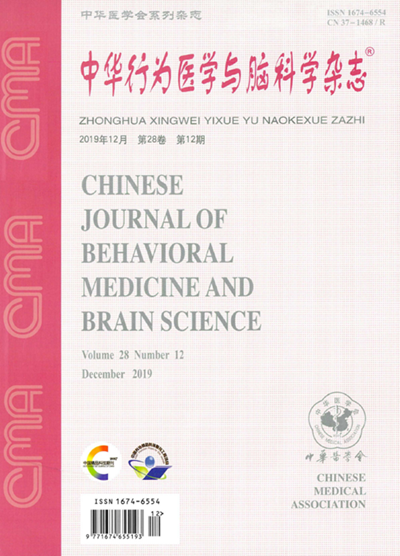腺苷脱氨酶作用于RNA在社会隔离小鼠攻击行为缓解中的作用及5-羟色胺- 2c受体的作用机制
引用次数: 1
摘要
目的探讨作用于RNA 1的腺苷脱氨酶(ADAR1)对5-羟色胺-2c受体的抑制作用。方法将60只21日龄健康雄性BALB / c小鼠随机分为6组:社会隔离组、社会对照组、ADAR1诱导剂社会隔离组、ADAR1抑制剂社会隔离组、ADAR1诱导剂社会对照组和ADAR1抑制剂对照组。以单笼饲养4周的小鼠为社会隔离模型,以组鼠饲养4周的小鼠为对照组。ADAR1诱导剂社会隔离组和ADAR1抑制剂社会隔离组小鼠分别腹腔注射ADAR1诱导剂(5.0×104 U/kg)和抑制剂(10 mg/kg)。采用进驻-侵入试验评价小鼠的攻击行为。采用免疫组织化学和Western blot检测小鼠脑组织中ADAR1和5- 5-羟色胺-2c受体的表达。结果社会隔离组的攻击潜伏期显著低于社会对照组((43.15±6.99)s,(542.40±30.50)s;t=15.906, P<0.01), ADAR1诱导性社会隔离组的发作潜伏期((256.70±29.49)s)显著高于社会隔离组(t=7.046, P<0.01)。ADAR1抑制剂社会隔离组的发作潜伏期((15.25±2.18)s)显著低于社会隔离组(t=3.809, P<0.01)。社交隔离组小鼠杏仁核ADAR1免疫反应细胞的光密度显著低于社交对照组相应脑区(BLA:(0.038±0.002),(0.074±0.004);LaDL:(0.033±0.002),(0.060±0.002);LaVM:(0.045±0.003),(0.073±0.004);Lavl面积:(0.044±0.003),(0.070±0.003);t=8.428, 9.037, 6.462, 5.698, P均<0.01)。ADAR1诱导物社会隔离组小鼠杏仁核中ADAR1免疫反应阳性细胞的光密度(BLA:(0.060±0.003)、LaDL:(0.042±0.002)、LaVM:(0.056±0.004)、Lavl:(0.054±0.003)显著高于社会隔离组小鼠相应脑区(t=6.055、2.876、2.312、2.492;所有P < 0.05)。社会隔离组杏仁核中ADAR1蛋白和5-羟色胺-2c受体蛋白的表达量显著低于社会隔离组(t=11.37, 12.65;P < 0.01)。ADAR1诱导物社会隔离组杏仁核中ADAR1蛋白和5-羟色胺-2c受体蛋白的表达量显著高于社会隔离组(t=3.02, 4.401;P < 0.05)。结论ADAR1诱变剂通过提高社会孤立BALB/c小鼠杏仁核中5- 5-羟色胺-2c受体的蛋白表达,减轻了BALB/c小鼠的攻击行为。关键词:社会隔离;攻击行为;作用于RNA 1的腺苷脱氨酶;5-serotonin-2C受体;老鼠本文章由计算机程序翻译,如有差异,请以英文原文为准。
The role of adenosine deaminase acting on RNA in the remission of aggression behavior in socially isolated mice and the mechanism of 5-serotonin-2C receptor
Objective
To investigate the effect of adenosine deaminase acting on RNA 1 (ADAR1) on 5-serotonin-2c receptor in alleviating aggression in socially isolated mice.
Methods
Sixty healthy male BALB / c mice aged 21 days were randomly divided into six groups: social isolation group, social control group, ADAR1 inducer social isolation group, ADAR1 inhibitor social isolation group, ADAR1 inducer social control group and ADAR1 inhibitor control group.The mice fed in single cage for 4 weeks were used as social isolation model while the mice fed in group were used as control group.ADAR1 inducer (5.0×104 U/kg) and inhibitor (10 mg/kg) were given intraperitoneally to mice in the ADAR1 inducer social isolation group and the ADAR1 inhibitor social isolation group respectively.The aggressive behavior of mice was evaluated by resident-intruder test.The expression of ADAR1 and 5-serotonin-2c receptors in the brain of mice was detected by immunohistochemistry and Western blot.
Results
The attack latency of social isolation group was significantly lower than that of social control group ((43.15±6.99) s, (542.40±30.50) s; t=15.906, P<0.01), and the latency of attack ((256.70±29.49) s) in the ADAR1 inducer social isolation group was significantly higher than that in the social isolation group (t=7.046, P<0.01). The latency of attack ((15.25±2.18)s) in the ADAR1 inhibitor social isolation group was significantly lower than that in the social isolation group (t=3.809, P<0.01). The optical density of ADAR1 immunoreactive cells in the amygdala of the social isolation group mice was significantly lower than that in the corresponding brain area of the social control group (BLA: (0.038±0.002), (0.074±0.004); LaDL: (0.033±0.002), (0.060±0.002); LaVM: (0.045±0.003), (0.073±0.004); Lavl area: (0.044±0.003), (0.070±0.003); t=8.428, 9.037, 6.462, 5.698, all P<0.01). The optical density of ADAR1 immunoreactive positive cells in the amygdala (BLA: (0.060±0.003), LaDL: (0.042±0.002), LaVM: (0.056±0.004), Lavl: (0.054±0.003) in the ADAR1 inducer social isolation group was significantly higher than those in the corresponding brain area of the social isolation group mice (t=6.055, 2.876, 2.312, 2.492; all P<0.05). The expression of ADAR1 protein and 5-serotonin-2c receptor protein in amygdala of social isolation group were significantly lower than those of social isolation group (t=11.37, 12.65; P<0.01). The expression of ADAR1 protein and 5-serotonin-2c receptor protein in the amygdala of the ADAR1 inducer social isolation group were significantly higher than those of the social isolation group (t=3.02, 4.401; P<0.05).
Conclusion
ADAR1 inducer alleviates the aggressive behavior of social isolated BALB / c mice by enhancing the protein expression of 5-serotonin-2c receptor in the amygdala of social isolated BALB/c mice.
Key words:
Social isolation; Aggressive behavior; Adenosine deaminase acting on RNA 1; 5-serotonin-2C receptor; Mice
求助全文
通过发布文献求助,成功后即可免费获取论文全文。
去求助
来源期刊
自引率
0.00%
发文量
8131
期刊介绍:
"Chinese Journal of Behavioral Medicine and Brain Science" (CN 37-1468/R, ISSN 1674-6554) is a national academic journal under the supervision of the National Health Commission, sponsored by the Chinese Medical Association and Jining Medical College. The journal was founded in June 1992 and was formerly known as "Chinese Journal of Behavioral Medicine" (1992-1993) and "Chinese Behavioral Medical Science" (1994-2008). In 2009, it was renamed "Chinese Journal of Behavioral Medicine and Brain Science" with the approval of the State Administration of Press, Publication, Radio, Film and Television.
The purpose of "Chinese Journal of Behavioral Medicine and Brain Science" is to implement the health and health policies of the Party and the State, implement the principle of combining theory with practice and popularization and improvement, and reflect the major progress in the theory and practical application of behavioral medicine and brain science in my country. It publishes academic papers and scientific research results in the field of behavioral medicine and brain science in my country, and has columns such as monographs/reviews, basic research, clinical research, health prevention, methods and techniques, psychological behavior and evaluation, and systematic evaluation.

 求助内容:
求助内容: 应助结果提醒方式:
应助结果提醒方式:


